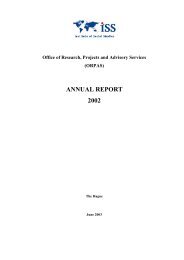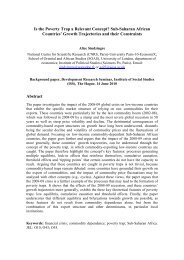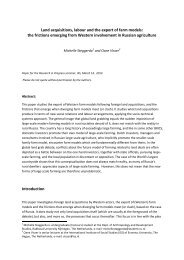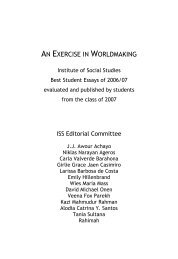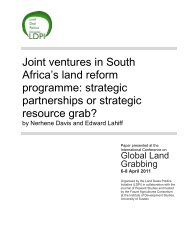AN EXERCISE IN WORLDMAKING 2009 - ISS
AN EXERCISE IN WORLDMAKING 2009 - ISS
AN EXERCISE IN WORLDMAKING 2009 - ISS
You also want an ePaper? Increase the reach of your titles
YUMPU automatically turns print PDFs into web optimized ePapers that Google loves.
4 Labour Rights Governance, Decent Work and Global Value Chains 43<br />
comings of the company code for the enforcement of labour rights. In<br />
2002, the Spanish NGO, SETEM, issued a striking report about the social<br />
responsibility of Spanish textile companies in production sites in<br />
Morocco. The report found important labour and human rights violations<br />
in some of the factories where Inditex had outsourced its production.<br />
Especially alarming was the situation of the female workers, some<br />
of 12 years of age (SETEM, 2002). Comparable concerns about the<br />
company production practices were raised in similar reports issued in the<br />
years 2003 and 2004 (Campaña Ropa Limpia et al., 2003; Intermón<br />
OXFAM, 2004). The company was also found to be sourcing from two<br />
illegal manufacturing workshops in Galicia and Catalunya in 2003, where<br />
migrants worked up to 17 hours per day under very poor working conditions.<br />
Awareness protests have also taken place against the company in<br />
2005 in Galicia, when the women’s association Mulheres Transgredindo<br />
organized different street actions in front of Inditex subsidiaries.<br />
The case Spectrum was probably the most serious failure of labour<br />
rights enforcement. Spectrum was a factory in Bangladesh where Inditex<br />
together with other European brand names were sourcing from. The<br />
factory had repeatedly been audited by BSCI and other company monitoring<br />
programmes, failing to ensure safety and healthy working conditions<br />
as well as to address the extreme abuses that workers were facing.<br />
The factory collapsed in April 2005, killing 64 workers (Clean Clothes<br />
Campaign, 2005). This and the mentioned examples show the weakness<br />
of a complete code of conduct which is issued unilaterally and lacks of<br />
real implementation, monitoring and enforcement mechanisms.<br />
In 2007, the company signed an IFA with the International Textile,<br />
Garment and Leather Workers Federations (ITGLWF). According to the<br />
ITGLWF, the agreement was the outcome of a long ongoing relationship<br />
with the company towards ensuring decent work (ETUF-TCL,<br />
2007). In the textile sector, an IFA negotiation is far more complicated<br />
than in other sectors. The high number of code of conducts, the established<br />
anti-union stance of some multinationals and the possible collective<br />
employer resistance are important factors underlining this complexity<br />
(Miller, 2004).<br />
However, the cautiousness and bargaining capacity of the ITGLWF<br />
during the discussion process was well worth it. The agreement was described<br />
as ground-breaking. It was not only the first to be signed in the<br />
textile sector, but also the very first one to cover a retail supply chain and




